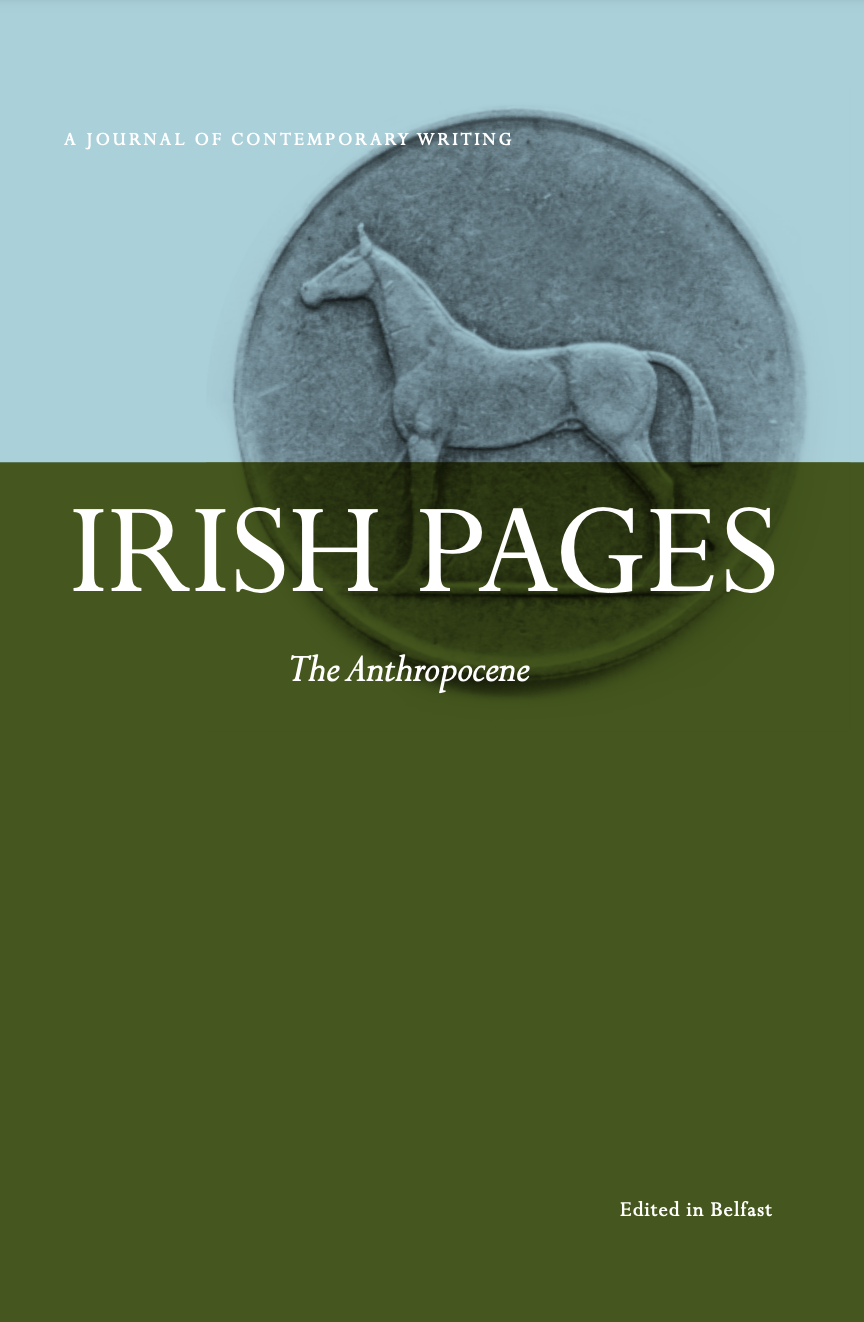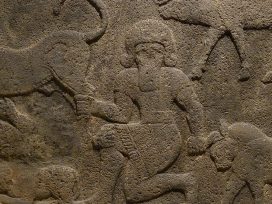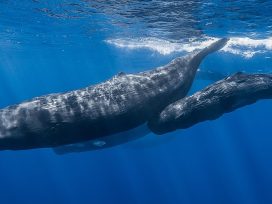Wildlife conservationists often have to risk their own safety to protect endangered species from armed gangs. The market value of Asian elephant tusks, for example, entices certain impoverished locals into poaching. And at the crux of this perilous and twisted Anthropocene reality lies an increasingly aggressive animal’s fight for survival.
It is February 2020. The first Covid case has just been detected in India, a pandemic is ambushing the world but we don’t know, we are intent on what is near us in the dark.
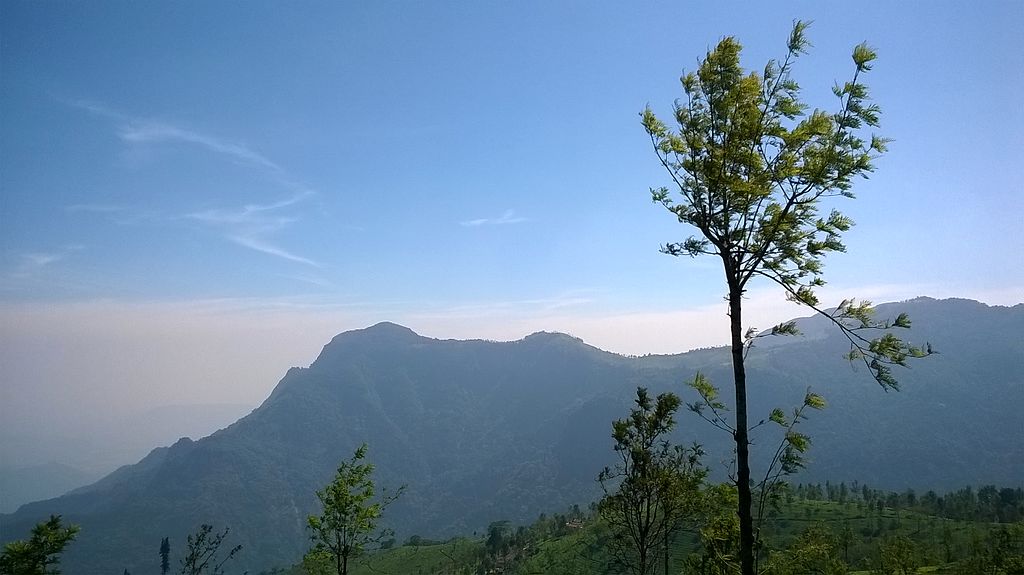
Nilgiri hills, photo from Wikimedia Commons
In daylight, this stony soil is the colour of milky tea overlain by dry grass. The horizontal rays of early morning will turn all this to honey gold, but under a night sky and a full moon everything is a lacework of silver and black.
Dense forest starts a few hundred yards away but the clear ground round the house, dotted with trees and bushes, is pale and lit. I stare at the outline of a chin-high square of cement, the water tank behind a fat tree, where the ground slopes towards the river.
Behind that tree, half in shadow, are the tusks, trunk and double-domed forehead of a wild Asian elephant. He has come to drink, silk-silent. We never heard a sound. The Nilgiri biosphere has the largest population of Asian elephants in the world.
His trunk dips into the water, curves up, pours water down his throat in the moonlight. The night rustles, he drinks, we watch.
Behind this veranda is the kitchen. Last night, Jean Philippe showed me the spot in it where he once stood underneath the thrusting tusks of a wild bull elephant, mad for fruit, doing his best to rip off the roof. Jean Philippe lit flares to scare him away. Afterwards, they reinforced the roof with steel girders and bought zinc-lined containers which even the longest, most sense-receptor rich noses cannot smell through, to store fruit.
He knows we are here. Any noise or sudden movement and he’d be off. His fragile trust in this place is the result of 50 years’ work protecting this 30-acre patch of forest between two villages.
Priya’s father bought the land in 1964 and built this bungalow. (I cherish his books about this forest, especially Whispers from the Wild.) If he hadn’t, the villages would have merged and wild animals would have lost access to the river. Priya, Jean Philippe and Peter protect the forest from anyone who tries to harm it. By grazing cattle in it for instance, or taking timber, or building illegally at its edge. They keep their impact on it as light as possible, don’t try to make friends with animals or feed them, simply protect access to the river and fill the water tank.
My first afternoon, we watched from this veranda a family of dhole, India’s wild red dog, trotting along the river bank. Last night, a bear and her cubs walked across in front of us, snuffling the ground. I often see drifts of chital, the spotted deer, and sometimes sambhur, grazing, browsing, drinking at the river. Sometimes a tiger calls at night.
15 years ago, I wrote a book about wild tigers and their conservation. Starting at the millennium, I explored tiger forests on foot, in jeeps and on trained elephants, in India, Bangladesh, Nepal, Bhutan, South East Asia, Indonesia, Russia and China. I dreamed tigers. I thought I could never feel so connected to any other wild animal.
Given the degradation and shrinking of forests, the loss of wild habitat everywhere on the planet, I wondered if that was the last time anyone could go into all those forests and see signs of tiger. Growth in human populations, expansion of agriculture and livestock farming, means more tigers are coming into conflict with humans all the time. They eat goats and cows, sometimes kill people too, and get poisoned in revenge.
But in India, there seem now to be more tigers than there were then, because those years coincided with a big surge in tiger poaching which in some places has been beaten back. The media hail optimistic tiger surveys which say tigers are on the up.
However, counting animals that don’t want to be seen is a tricky business, and scientists say the surveys are flawed. Also more trees are being cut, more roads are being built, more people are driving, and so more and more wild animals, including tigers, are getting killed on India’s roads. The tigers are still here though, and meanwhile I am starting to write about elephants.
I never expected to. In Indian forest, elephants were the ones I was most afraid of. They kill so easily, are so quick and so emotional, and hate being disturbed. Other animals try to get away from human beings. But elephants evolved to think everyone should get out of their way. Today, with so many more people, elephants are under pressure as never before. Maybe that is how mammoths felt before they died out.
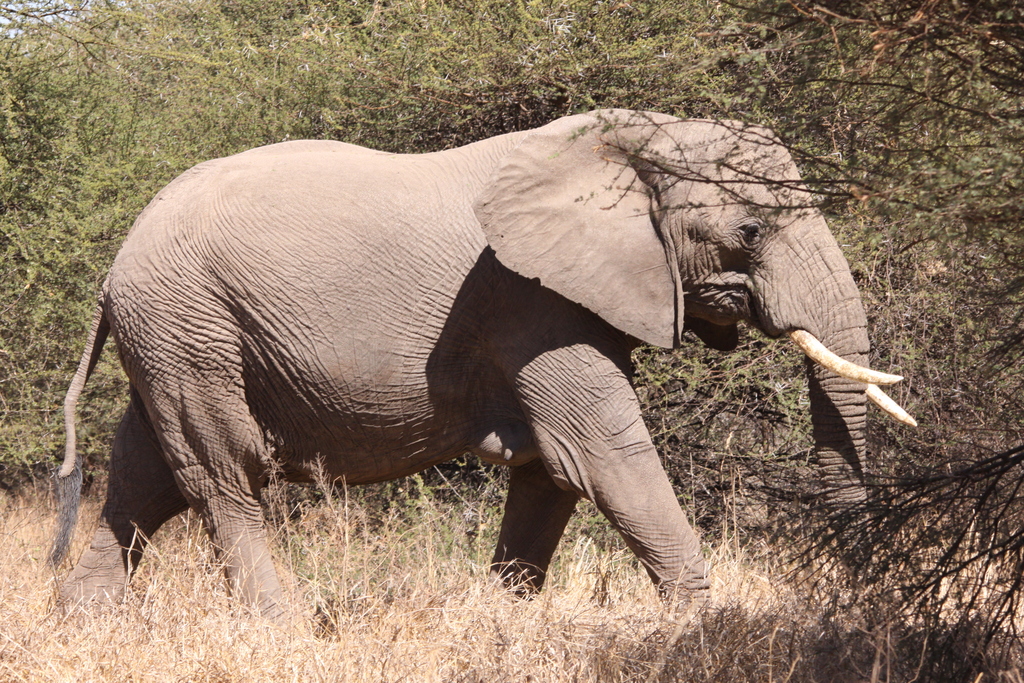
African elephant, photo by Derek Keats from Flickr
Africa’s elephants are not worked. Fascinating and complex as they are, they are purely wild animals. The ones Hannibal took over the Alps were probably a smaller North African species which has since gone extinct. Africa also has a smaller forest elephant, genetically different from the best-known elephants, the giants of the savanna who have genetic and biological differences from Asian elephants. They are larger, with larger ears. Both sexes have tusks. And they have never been tamed and worked.
Asian elephants are very different. Down the millennia, the relationship human beings have created with them, on the subcontinent, in Sri Lanka and South East Asia, and more far-reachingly the imaginative relationship all of us have with them in our heads, is far more complex than with a cat that keeps to itself.
We have hunted tigers, displayed them in zoos, made them do circus acts. Selling their skin and bones illegally makes some people a lot of money. But we can’t make tigers do anything actually useful to us, whereas Asian elephants have been caught in the wild and kept captive, have been trained, and worked in transport and logging industries, also in hunting and in mass ceremonies demonstrating kingly power and religious worship. Also used, until very recently, in war. There is a procession of horses, dogs, mules and pigeons carved on a Hyde Park war monument, in London, to animals killed on active service. It is led by an Asian elephant.
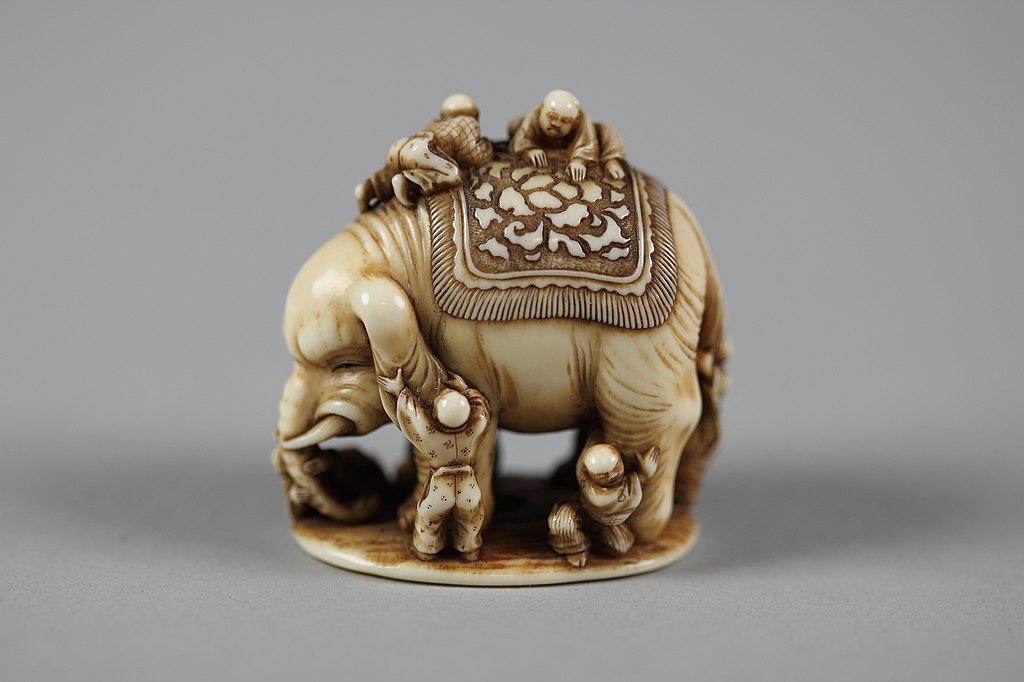
Blind men and the elephant, photo from Wikimedia Commons
An elephant is the most ancient image in the world for the different ways different people try to make sense of how they perceive the world. Six blind men encounter an elephant. They feel it, and then theorise about what they perceive. The story probably began here, in India, in the first millennium BC. Relativism was cool in the first millennium: somewhere between 1500 and 1200 BC, the Rig Veda said, ‘Reality is one, though wise men speak of it variously’, and the men in this story do what humans do, variously: try to explain what an elephant is. Or rather, since we invoke metaphor to explain the unknown and don’t always realise that what we are using is metaphor, they explain what it is like. One feels the trunk and says the elephant is a snake. One fingers an ear and calls it a fan. One feels the round of its leg and thinks it is a tree, one runs his hand along its flank and calls it a wall. One grabs the tail and calls it a rope, the last discovers a tusk and calls it a spear. In some versions, they come to blows over their competing interpretations.
About 500 BC, a Buddhist version of the story spread to China, then to the Arab world and Sufism. Philosophers have used it to argue for the intangibility of truth, and respect for different perspectives; they have drawn more morals from it than there are blind men in it. The elephant is reality. Or God, or truth. We use our limited subjective experience to decide what is true and brush aside other people’s ideas. Sometimes, to defend our own opinion, we go to war.
The story has not done much to resolve human conflict but does illustrate the many contradictory aspects of our relationship with elephants themselves.
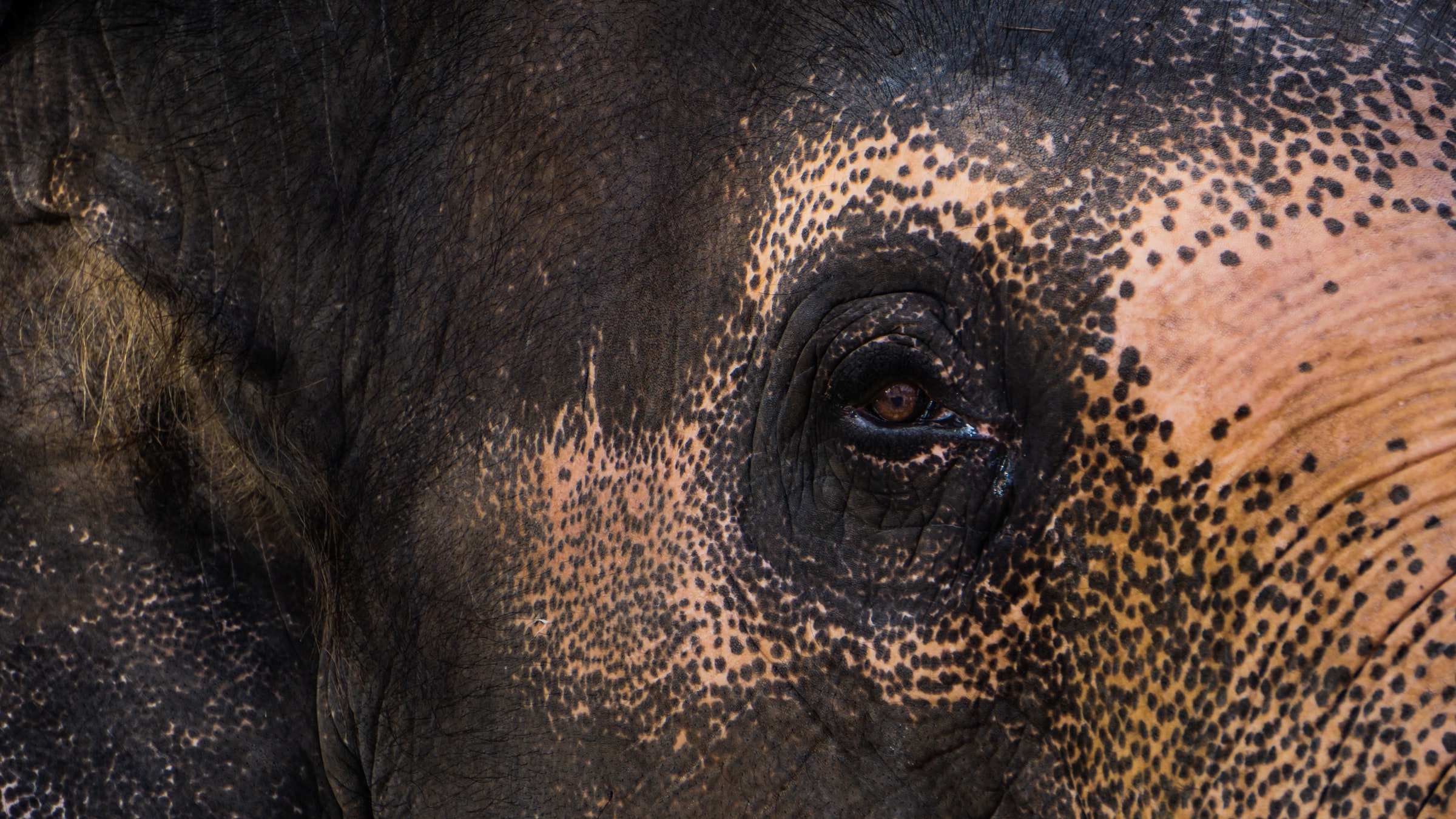
Photo by Apsara on Unsplash
Writing about an animal is also writing about yourself. Even if you have never seen one in real life or in the wild, or if you blank out that dimension of your writing, you are still working out of your own imaginative relation with it. Thinking about elephants, and our relations with elephants, means examining how human beings treat captive and working animals, as well as wild ones. Despite their extraordinarily different bodies, elephants seem to share with us a lot of emotions and social behaviour. Strong family bonds, for instance. They recognise themselves in a mirror. They mourn their dead. They seem to feel and express gratitude, even to us.
I have watched over and over again a YouTube video, made very near here on an I-phone, in which a wild elephant thanks workmen for rescuing a baby elephant.
The baby has fallen in a very deep muddy ditch. The adults squeal and trumpet and worry, mill around, reach down but cannot help. Their weight makes things worse, the ditch walls fall in more. Then the labourers who made the ditch bring up a bulldozer. The wild elephants, very upset, retreat and watch while the men use the bulldozer to pile up mud at the bottom of the ditch and the baby manages to scramble out.
It wobbles off to re-join the herd in nearby jungle. There is a lot of joyful trumpeting. Then one adult elephant rushes out from the trees, stops and stares at the men from a distance. Finally she raises her trunk at them and disappears. No one can really say for sure what most animal behaviour means. She could be saying, with good reason, ‘If you didn’t mess with our landscape this would never have happened.’ But what it looks like is a wild salute, a ‘Thank you’.
Above all, there is empathy. Elephants care how others feel.
I once had a bareback elephant riding-lesson in Nepal. I was there for tigers, but I hung out with the elephants trained to carry tourists into the grasslands to look for tigers, and the people who looked after them. Who, after my lesson, told me about the birth of their one tusker, many years before.
They had not realised the mother was pregnant. She was ridden that afternoon but at night there was a wild noise in the elephant lines, trumpeting and squealing. The mahouts dashed over and found the other elephants had broken their picket chains and were standing either side of her, holding her up while she gave birth. Then they all clustered protectively round mother and child.
Elephants respond immediately to another elephant calling for help. Just as we put an arm round someone in tears, they reach out their trunk to embrace them and calm them, they even put their trunk in the other’s mouth, which seems to be a way of saying, ‘I’m here to help you’.
The only other animals who identify another’s distress, and try to comfort and console them physically are the great apes, some members of the crow family, and some dogs. And some humans. In this year of 2020 it would be nice but maybe over-optimistic to think most.
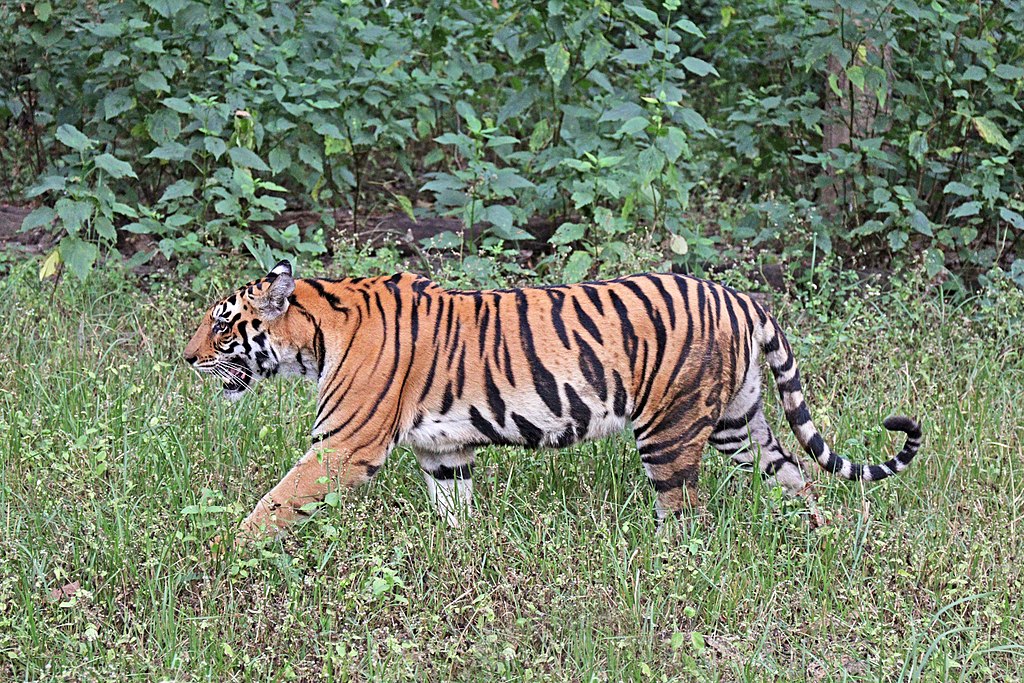
Bengal tiger, photo from Wikimedia Commons
In 2001 when I started researching tigers, I soon learned that there was everywhere, as the field zoologist George Schaller put it, a great dying. Field zoologists knew then, better than anyone, that we were staring into an abyss. Kayaking down a side-river in Laos, lurching nervously towards the mighty Mekong River, I came to a stark realisation. Darwin reached his insights into how species evolved by sailing round South America. 150 years later, I under- stood that my small journeys through South Asia, in search of tigers, were going to end in the opposite understanding: how species go extinct.
I asked experts in the field how they dealt with despair.
‘We do what we can, those of us who love the wild’, said a conservationist in a mangrove forest in Bangladesh.
‘You have to switch off on Friday nights or you’d go mad’, said an ex-commando who taught forest guards in Cambodia and Vietnam how to deal, physically and legally, with armed gangs of illegal loggers.
‘You have a choice, do something or do nothing’, said a wildlife vet, the first person to radio-collar a wild tiger in Sumatra. ‘And I know what I decided.’
20 years on, forests everywhere are in crisis. Human population growth and pollution, the plunder of timber, animals and forest land, are all made a million times worse by galloping climate change. This past decade has been the hottest in Earth’s history. Rivers are drying, even the wonderful Mekong, now threatened by Chinese dams. Flooding, fires, hurricanes and heatwaves. Storms, droughts, melting permafrost. Fires in the Amazon, glaciers collapsing in front of our eyes.
Already in February 2020 feels like a year of reckoning in the ledgers of the earth. Last year, over four environmental activists every week around the world were killed by companies destroying nature through mining, agribusiness and logging.
In this last month of innocence before the world wakes up, to a virus we brought upon ourselves by our intrusions into the wild, we are reeling from what has been happening in Australia, where scientists have been warning for years that clearing land for agriculture, mining and development was making the bushfires worse. At this very minute, 33,000 square miles of forest are burning, along with nearly three billion wild animals.
In the developed world, environmentalists are not usually murdered in the interest of making money, just side-lined, and portrayed as marginal by media on the side of the vested interests, while wild habitat is lost and wildlife extinctions increase.
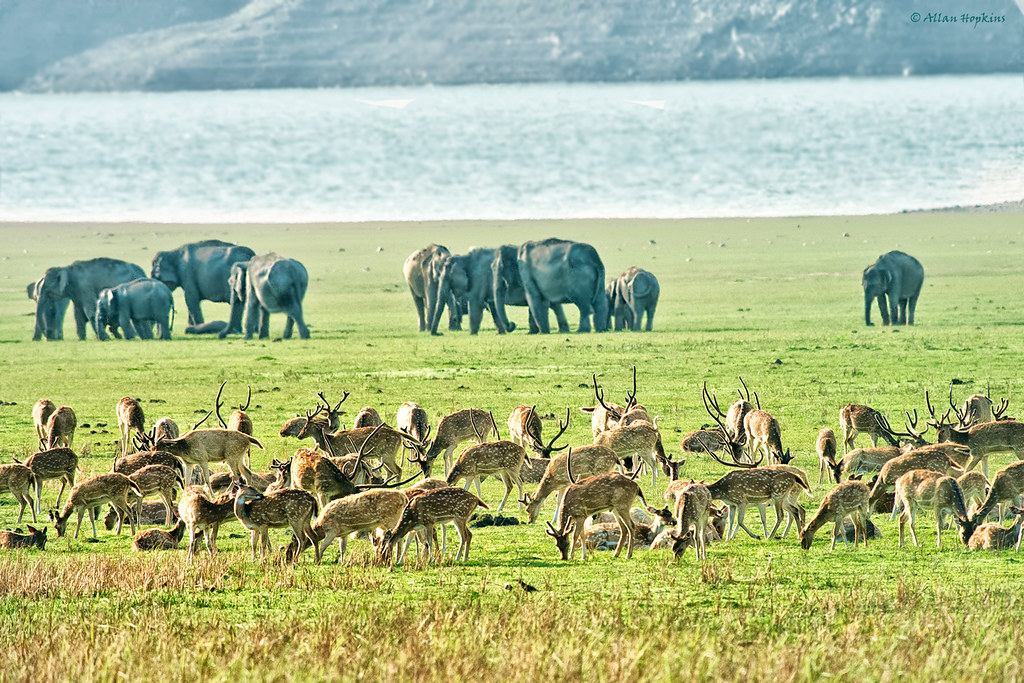
Chital and Indian elephant, photo by Allan Hopkins from Flickr
How does all this affect elephants in the Nilgiri Hills?
This island of forest lies on one of the ancestral elephant migration routes that vein the sub-continent. Jean Philippe has been mapping these routes. They are the ancient connectivity, the blood flow of the land. Tigers are solitary and territorial. Once they have won a territory, they stay in it. Elephants are social nomads. They evolved to move on and then return when plants they fed from, and fertilised, have grown back. To eat the enormous amount they need each day, they have to migrate over long distances.
Human barriers now block these routes. Cities, factories, farmland. Busy railways, ditches, highways, vast dams. Elephants are electrocuted by electric fencing and sagging high voltage power lines, try to cross fences of wood and metal, get hung up on them and die halfway over. The photos are terrible. Huge animals, folded in half, dying on a railing like grey deflating laundry.
There are also miles and miles of mines, for gold, diamonds, bauxite, manganese, iron, you name it. Asia is too rich, in what we call resources, for the elephants’ good.
So are the elephants themselves. In the last four decades, seventy per cent of elephants worldwide have disappeared. International trade in ivory is at last illegal but each country makes its own laws about domestic sales, of ivory from elephants killed before it was made illegal. The cut-off year was 1990. Today, nearly all countries have banned domestic trade entirely. Even China, the largest consumer of ivory in the world. But a few countries still allow it. Ivory is very difficult to date, so it is easy for ivory from elephants killed illegally, since 1990, to enter the domestic market in, for example, Canada, where selling pre-1990 ivory is still legal. And the black market worldwide is huge. A pound of ivory sells for 1,500 US dollars.
Every year, around 20,000 elephants are killed for their tusks. Among Asian elephants, it is only the males that have tusks, so they are the ones that get poached.
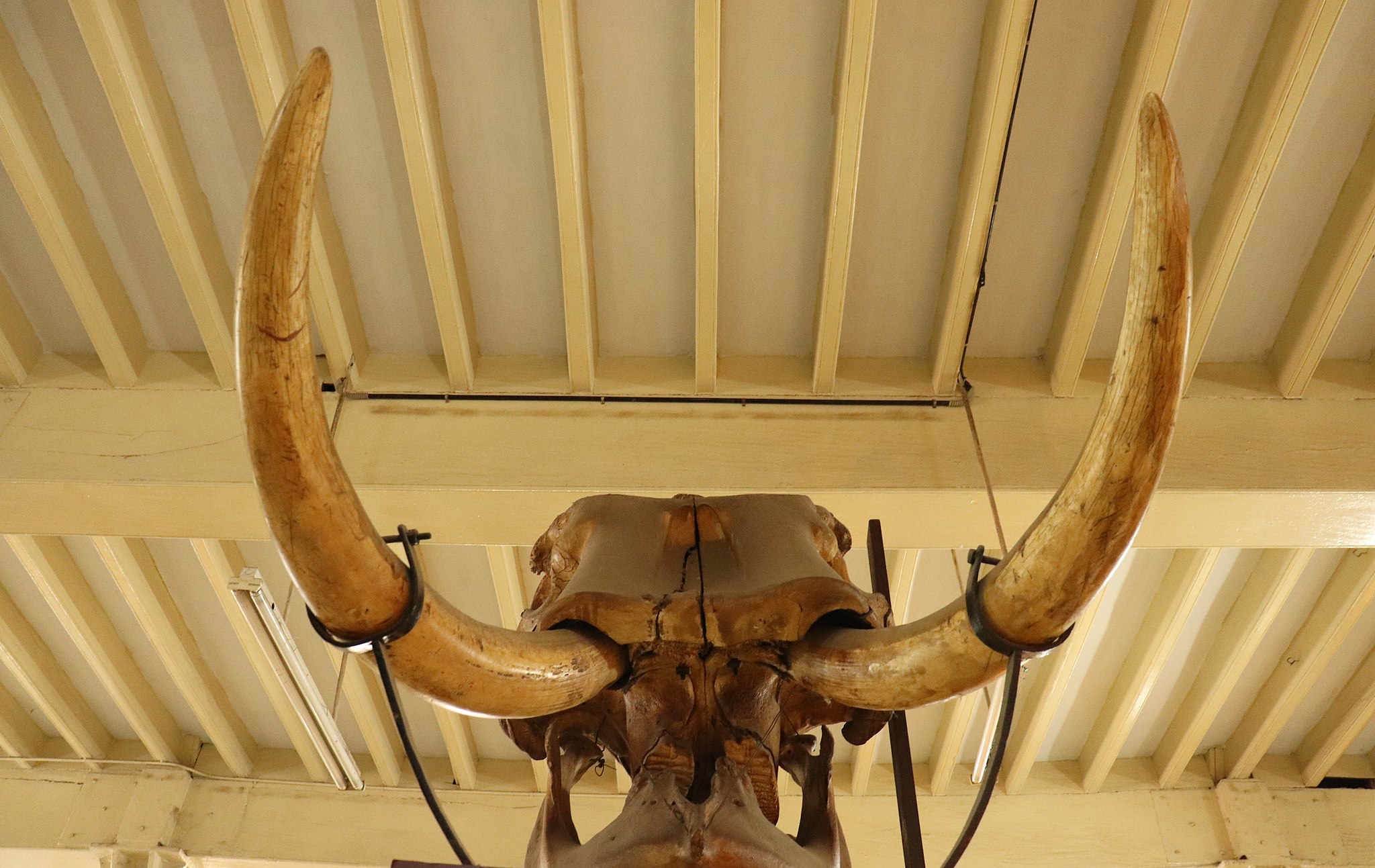
Indian elephant tusks, photo from Wikimedia Commons
All this tumbles through my head as we watch our visitor tip his head to pour water down his throat. His tusks glint in the moonlight.
Long tusks can weigh 250 pounds. The ivory he is carrying, through a countryside where the average family has less than 20 dollars surplus income a month, may be worth 350,000 dollars.
In the early days here, the sixties and seventies, Priya’s family saw elephants with huge tusks, and quite calm. Poaching was low, no one was harassing them. But we have been such bad predators to them and one by one those males were poached. No more enormous tusks.
Today, there is so much poaching, and so much of the land where the elephants’ natural food grows has disappeared, that conflict has increased between hungry elephants and poor people protecting their crops. Poisoned, shot at, electrocuted, elephants are becoming more and more – well, to themselves, anxious, angry, suspicious, embittered, het up. And to human beings, dangerous.
In the last five years, 2,036 humans and over 500 elephants have been killed in human elephant-conflict. (Conflict with tigers killed 275 people in the same years.) Last year, nearly 500 people died. North-east of here, in Orissa where my brother has spent most of his life, 115 people were killed, and 132 injured, in human-elephant encounters. Orissa’s Keonjhar district, torn by large-scale iron and manganese mines, reported 112 elephants in the 2002 elephant census. In 2017 it reported only 40.The destruction of elephant habitat there, and elephants, had made human-elephant conflict worse. Just last month there, in January, in Hariharpur village, a tusker trampled to death a ten-year-old girl playing outside her home.
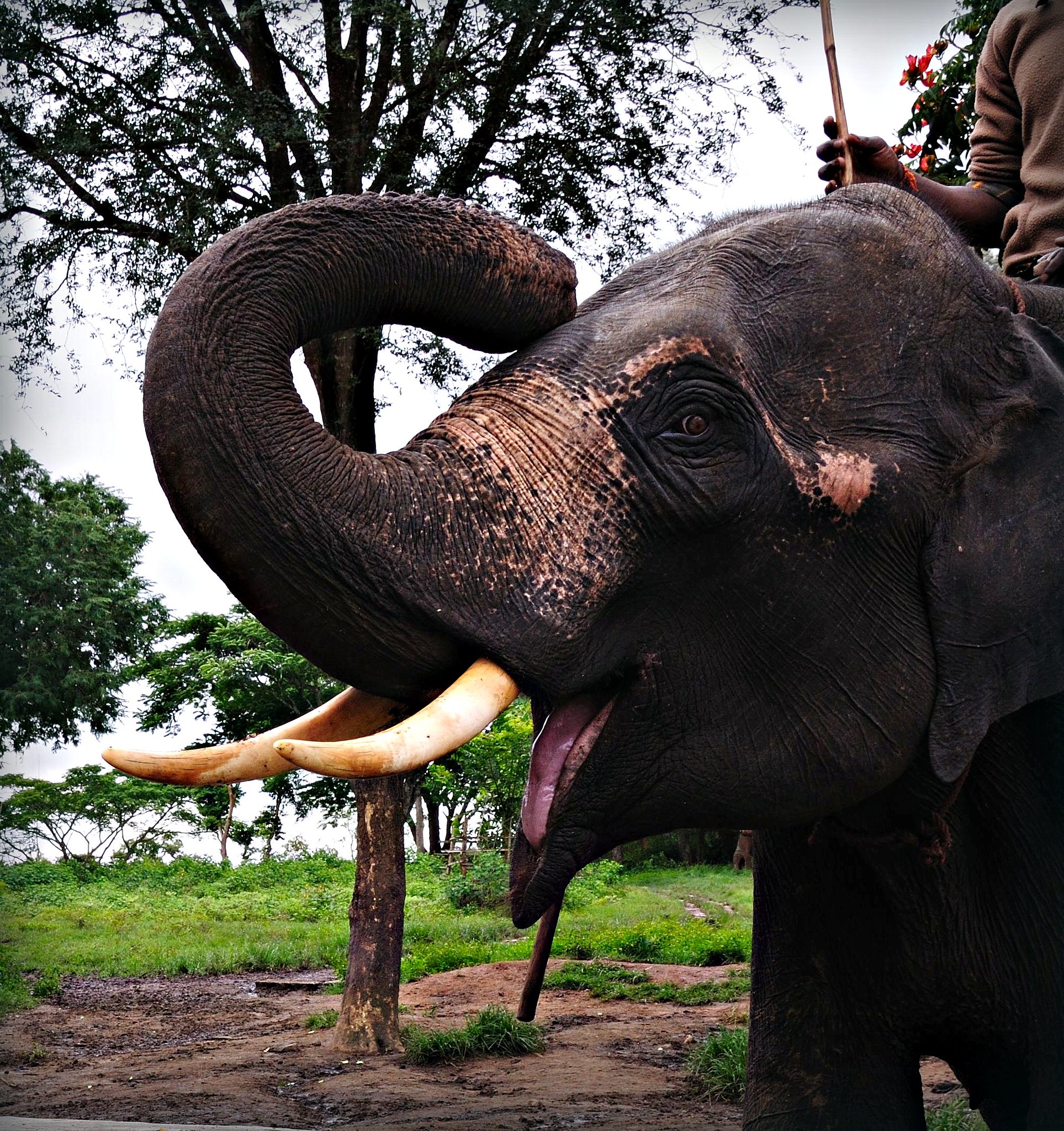
Indian tusker, photo by Reji from Flickr
The tusker in the moonlight finishes drinking and stands very still beside the tank.
Adult male elephants generally live and travel alone. The small herds are made up of closely related females, babies, and half-grown children, led by a matriarch. This quiet lone standing is classic male. They do it for hours, like meditation.
What is going on in his enormous head? Their brains are four times bigger than ours. What is he thinking about, what is he feeling?
We do have a lot in common, emotionally and socially, with elephants. But suppose they have more emotions than we do? Deeper, subtler, more sensitive?
We know there are worlds beyond our limited senses, that animals know things in ways we can’t. Other animals see different wavelengths and colours than us. Bumblebees sense the electrical field of flowers ripe for pollination. Birds live in a richer-coloured world than us, full of signs and messages we’ll never see. Hummingbirds distinguish sources of the nectar they feed on because they can see colours outside the spectrum of the rainbow.
Elephants call to each other in bass rumbles too deep for human hearing, and feel vibrations through the soles of their feet and hairs on their trunk from miles away. Maybe they have emotions, too, which we cannot imagine, or social and even moral feelings, beyond the rainbow of our own.
This is his forest. We don’t go in. Even in daylight, I have been warned to look round very carefully, walking the few yards to my own one-room bungalow. Elephants might be anywhere. They are surprisingly silent and are the colour of dust, of shadow. You don’t see them till you are on them, and they can move amazingly fast.
The only thing a bull elephant has evolved to be afraid of is another like himself, but he won’t want any other animals in his space. I’ve seen an elephant chase away a pack of dhole, furiously, squealing, ears flapping.
In a mock charge, designed to frighten off enemies, that is what they do – make a loud noise and flap their ears.That is how they chase off a mongoose or a harmless spotted deer. But when they mean business, when they want to eliminate an intruder, a danger, they attack in silence. And they are suspicious, with very good reason, of human beings.
Last year, Priya and Jean Philippe heard goons throwing firecrackers into the forest just beyond this slice of river.
‘Goon’ is a technical term for hired thugs. These ones work for a neighbour who keeps trying to encroach on the land. The goons, afraid of the elephants, were throwing firecrackers into the forest to scare them away.
Jean Philippe said he would go in and tell them to stop.
‘Be careful’, Priya said. ‘I saw an elephant there this morning.’
But the elephant seemed to have gone. Jean Philippe, furious about the firecrackers, walked down to give the goons a serious piece of his mind. Everything was dead quiet in the forest. But then a twig snapped at the edge. He stopped. He was just turning back when a tusker charged him out of the trees. He raced back towards the house but the elephant, also furious, very upset by the firecrackers, was much faster.
He looked behind and saw the trunk lifting up almost above him. Priya saw him sprinting desperately towards her, jumped up on this veranda wall, shouted, then leaped down and ran towards them both to deflect the elephant.
It swerved a little, which just gave Jean Philippe time to get into the house. It stopped, then careened off into the trees.
‘He meant to kill’, Jean Philippe told me. ‘Running at me, utterly silent.’
Last year’s dry season was one of the worst. The drought went on and on. Terrible heat and the river ran dry. One afternoon, they saw 13 elephants standing there by the water tank. The babies were on the point of collapse.
The tank was empty.
‘I’m going out to turn on the tap’, said Jean Philippe.
Priya couldn’t stop him. He walked out. He didn’t look at the elephants in front of him, just as I don’t look at the blackbird who waits on the fence for me to put crumbs on our kitchen windowsill. If I look at it, the bird flies away, it is used to me doing something purposeful for myself, weeding, digging, putting out crumbs, the natural things for me to do, but relating to it scares it off. I walk to the sill, not looking at it, put down the crumbs, and leave. As soon as I am back in the kitchen doorway, the blackbird flies to the sill. But a blackbird can’t kill me.
Elephants are far more dangerous than tigers. Tigers kill for food, or in defence. Elephants, wild or captive, kill because of how they feel. They kill with their head, feet, trunk or tusks. They trample, swipe, gore, crush; they can pick you up with their trunk and dash you on the ground. In zoos, the keepers killed most often are those who look after elephants. In forest, elephants will go for you just because you are there.
In front of 13 pairs of wild eyes, Jean Philippe walked to the tap and turned it on. It began to fill. But it’s a big tank. It took time.
There’s a subtle undertow of movement in elephant stillness. The tip of the trunk keeps delicately moving, testing smells in the air. And in great heat, the ears keep fanning out and back like gills of a fish because the veins of the ear help cool the blood.
As the tank slowly filled, the sun blazed on the parched soil and the parching elephants. Priya watched, terrified, from the house, Jean Philippe looked at the tap, not glancing up or facing them, and the elephants loomed. 13 gently pulsing enormous bulks, 13 trunks each packed with 150,000 muscle fascicles. The tip is like the tissue of our lips, packed with nerve endings, but one blow from a trunk can kill.
When the tank was full, he turned it off and walked slowly back to the house.
They came forward and dipped their trunks in the water.
The one who speaks for the wild, speaks for the world.
Published 12 July 2021
Original in English
First published by Irish Pages, Vol 11, No 1
Contributed by Irish Pages © Ruth Padel / Irish Pages / Eurozine
PDF/PRINTPublished in
In collaboration with
In focal points
Newsletter
Subscribe to know what’s worth thinking about.
Related Articles

Mineral rush
Topical: Critical raw materials
Why does peace in Ukraine hang on a ‘mineral deal’ whose handling is more reminiscent of trade than negotiations? Perhaps because the global race for critical raw material mining is well and truly underway, digging for today’s equivalent of gold: raw earth elements and lithium critical for renewables and digital technology but also modern weaponry.
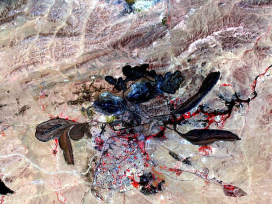
Excitement over ‘rare’ elements
Julie Klinger in conversation with Misha Glenny
The race for green transition supplies is on. But where’s the thrill in metals, discreet and hidden yet widespread? Mining, intensive due to low concentrations, throws up waste elements like arsenic. Space cowboys and deep-sea dredgers contest environmental stability more than China’s monopoly, based on 40-years of involved processing. Health and recycling regulations are a must.
